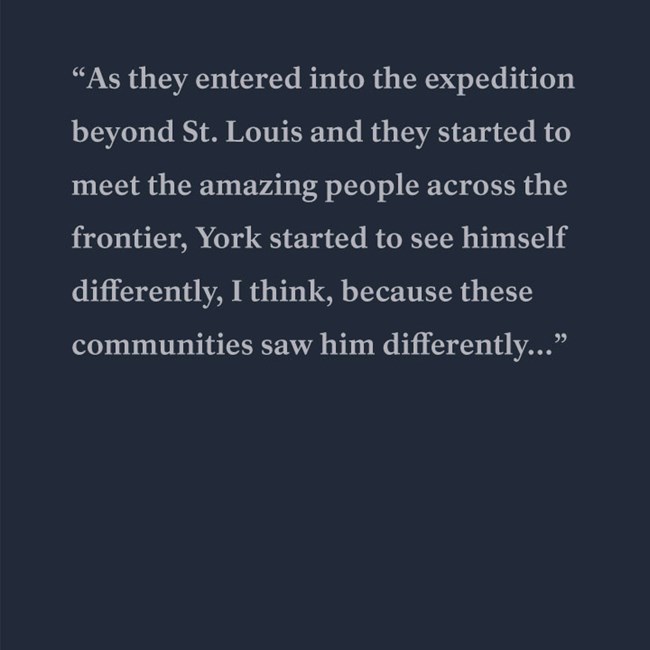Part of a series of articles titled Telling York's Story .
Article
Traveling West: York’s Service to the Lewis and Clark Expedition
This article is part of the series Telling York’s Story: with Living History Actor Hasan Davis.
To learn more about York vist Lewis and Clark National Historic Trail's People page.
During Living History Actor Hasan Davis’ decades long journey researching and portraying York, he has spoken with Tribal members who have shared stories with him, particularly during the Tent of Many Voices and other Lewis and Clark Expedition bicentennial commemoration events. These stories help Davis piece together a picture of York’s experience as he travelled further from the society that enslaved him.
“I was gifted with stories from elders from the Nez Perce.. from storytellers of the Missouria-Otoe who pulled me aside and said, no, let me tell you how we know York. You need to understand as you embody him that there is so much more. Those were amazing gifts.”
These oral histories, along with the Lewis and Clark journals and other historical accounts show that, as York travelled West with the Corps of Discovery, his value to the expedition grew beyond what Clark had imagined. Lewis and Clark fumbled through their initial diplomatic contacts with Tribes. The captains knew little of the complex politics among Plains Indians and gave certificates, medals, long speeches, and big promises. But the further the party traveled up the Missouri River, the more arresting York’s appearance became to locals. To Tribes encountering the expedition, the three-boat-band with a stingy supply of gifts and trade items was made more appealing by the presence of the large man with black skin.
On October 9, 1804, a cold, rainy day, on Great Plains Clark writes,
“ Sorry Canoos of Skins passed down from the 2 villages [2] a Short distance above, and many Came to view us all day, much asstonished at my black Servent, who did not lose the oppertunity of his powers Strength &c. &. this nation never Saw a black man before.”

Davis reflects on how these experiences may have impacted York.
“As they entered into the expedition beyond St. Louis and they started to meet the amazing people across the frontier, York started to see himself differently, I think, because these communities saw him differently,” says Davis. “As they gave him names like Black Indian or Big Medicine, as the Missouri-Otoe sub-chief who greeted them came right up to York and began to talk to him like he was a friend, Lewis and Clark had to explain to the sub-chief that York was just the guy with the guy.”
But York’s popularity with Tribes served as further proof that his successes and strength were not his own.
On New Years Day, 1805, while wintering with the Mandan, Clark writes,
"I ordered my black Servent to Dance which amused the Croud verry much, and Some what astonished them, that So large a man Should be active &c."
“William Clark recognized the value of York as another icebreaker, “says Davis. “Clark would get York to do feats of strength, and to dance on his hands, and to impress people, and then Clark could come back with the sales pitch, yeah, he’s amazing, he’s so powerful, and I own everything about him. And if he’s so powerful, imagine what I must be if I can control everything about him.”
While York’s size and black skin were exploited to win over local people, journal entries by Captains Lewis and Clark also depict York as a central member to the expedition: hunting, rowing, and laboring, and in several instances accompanying Clark on exploratory parties.
At perhaps the most famous crossroads of the expedition, the fork of the Marias and Missouri Rivers at a place now called Decision Point, the Captains parted to investigate the two rivers. In Clark’s small party went York.
On June 3, 1805, Lewis writes,
“Capt. C. and myself concluded to set out early the next morning with a small party each, and ascend these rivers untill we could perfectly satisfy ourselves of the one, which it would be most expedient for us to take on our main journey to the Pacific. accordingly it was agreed that I should ascend the right hand fork and he the left. I gave orders to Sergt. Pryor Drewyer, Shields, Windsor, Cruzatte and La Page to hold themselves in readiness to accompany me in the morning. Capt. Clark also selected Reubin & Joseph Fields, Sergt. Gass, Shannon and his black man York, to accompany him. we agreed to go up those rivers one day and a halfs march or further if it should appear necessary to satisfy us more fully of the point in question.”
What was York thinking as he traveled West and then home again with the expedition? Davis suggests that, tested by the journey’s great challenges, York’s sense of self grew and strained against the fate waiting for him back East.
“You know, the idea of there being something different on the way back, coming back into the ‘civilized world’ seemed to be really real for him,” says Davis. “My momma says ‘sometimes you can't unboil an egg.’ And I think that once York experienced all of that, he realized that his value, you know, wasn't attached to his skin but to his courage, his capacity, and his willingness to engage like other men and women in accomplishing something. So his expectations changed.”
Continue Reading
Read the next article in this series.
What happened to York when the expedition returned to St. Louis?
Previous Article
Read the previous article in this series.
Hasan Davis gives insight into York's early life and the nature of his relationship with his enslaver, William Clark.
Last updated: March 12, 2025
